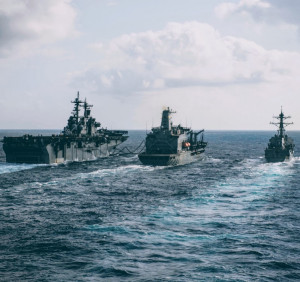
Per Fagereng is joined by Professor Michael T. Klare to discuss his recent article in Truthout about the US military's newly named Indo-Pacific Command. Call (503) 231-8187 to join the conversation.
from Truthout.org
On May 30th, Secretary of Defense James Mattis announced a momentous shift in American global strategic policy. From now on, he decreed, the US Pacific Command (PACOM), which oversees all US military forces in Asia, will be called the Indo-Pacific Command (INDOPACOM). The name change, Mattis explained, reflects “the increasing connectivity between the Indian and Pacific Oceans,” as well as Washington’s determination to remain the dominant power in both.
What? You didn’t hear about this anywhere? And even now, you’re not exactly blown away, right? Well, such a name change may not sound like much, but someday you may look back and realize that it couldn’t have been more consequential or ominous. Think of it as a signal that the US military is already setting the stage for an eventual confrontation with China.
If, until now, you hadn’t read about Mattis’s decision anywhere, I’m not surprised since the media gave it virtually no attention — less certainly than would have been accorded the least significant tweet Donald Trump ever dispatched. What coverage it did receive treated the name change as no more than a passing “symbolic” gesture, a Pentagon ploy to encourage India to join Japan, Australia, and other US allies in America’s Pacific alliance system. “In Symbolic Nod to India, US Pacific Command Changes Name” was the headline of a Reuters story on the subject and, to the extent that any attention was paid, it was typical.
That the media’s military analysts failed to notice anything more than symbolism in the deep-sixing of PACOM shouldn’t be surprising, given all the attention being paid to other major international developments — the pyrotechnics of the Korean summit in Singapore, the insults traded at and after the G7 meeting in Canada, or the ominous gathering storm over Iran. Add to this the poor grasp so many journalists have of the nature of the US military’s strategic thinking. Still, Mattis himself has not been shy about the geopolitical significance of linking the Indian and Pacific Oceans in such planning. In fact, it represents a fundamental shift in US military thinking with potentially far-reaching consequences.
Consider the backdrop to the name change: in recent months, the US has stepped up its naval patrols in waters adjacent to Chinese-occupied islands in the South China Sea (as has China), raising the prospect of future clashes between the warships of the two countries. Such moves have been accompanied by ever more threatening language from the Department of Defense (DoD), indicating an intent to do nothing less than engage China militarily if that country’s build-up in the region continues. “When it comes down to introducing what they have done in the South China Sea, there are consequences,” Mattis declared at the Shangri La Strategic Dialogue in Singapore on June 2nd.
As a preliminary indication of what he meant by this, Mattis promptly disinvited the Chinese from the world’s largest multinational naval exercise, the Rim of the Pacific (RIMPAC), conducted annually under American auspices. “But that’s a relatively small consequence,” he added ominously, “and I believe there are much larger consequences in the future.” With that in mind, he soon announced that the Pentagon is planning to conduct “a steady drumbeat” of naval operations in waters abutting those Chinese-occupied islands, which should raise the heat between the two countries and could create the conditions for a miscalculation, a mistake, or even an accident at sea that might lead to far worse.
- KBOO


